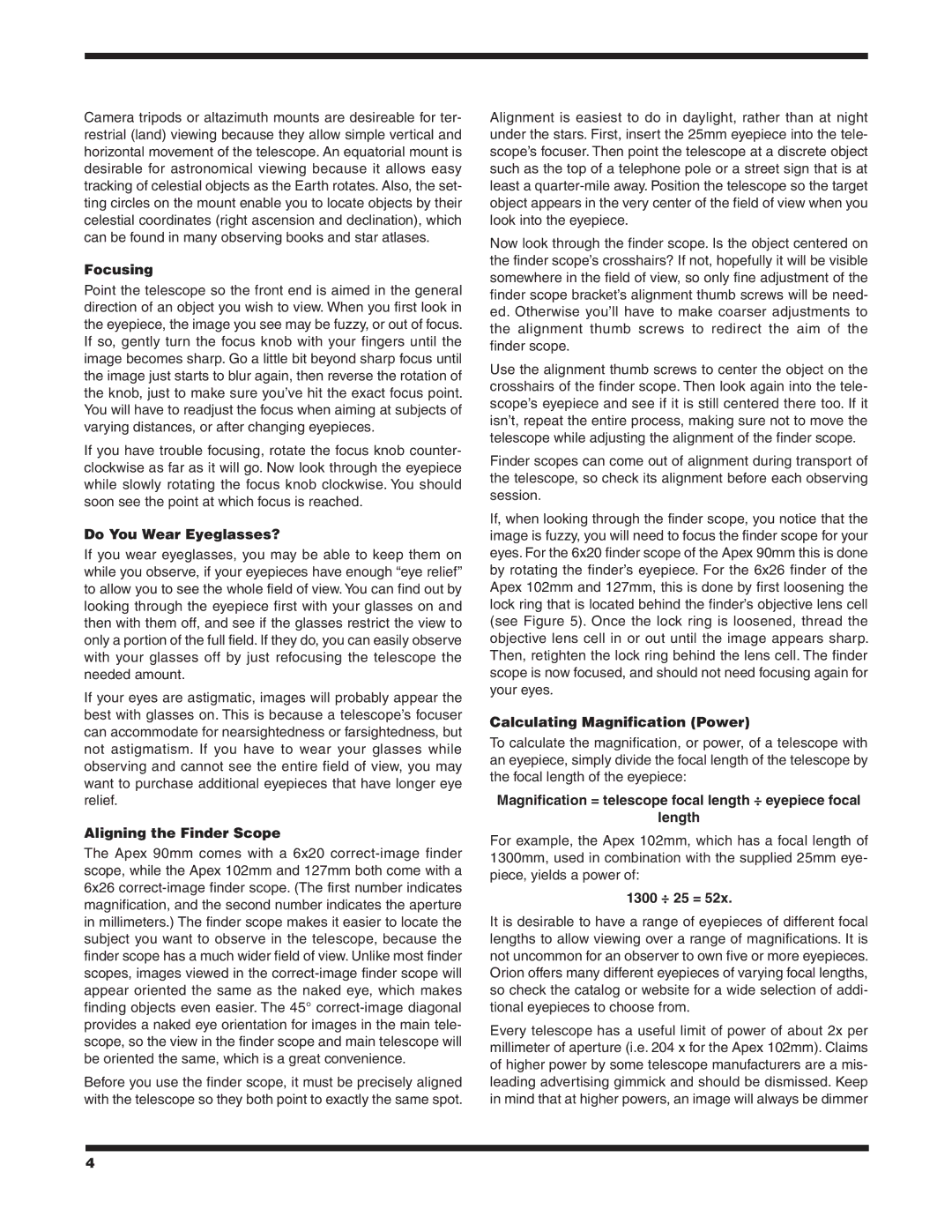
Camera tripods or altazimuth mounts are desireable for ter- restrial (land) viewing because they allow simple vertical and horizontal movement of the telescope. An equatorial mount is desirable for astronomical viewing because it allows easy tracking of celestial objects as the Earth rotates. Also, the set- ting circles on the mount enable you to locate objects by their celestial coordinates (right ascension and declination), which can be found in many observing books and star atlases.
Focusing
Point the telescope so the front end is aimed in the general direction of an object you wish to view. When you first look in the eyepiece, the image you see may be fuzzy, or out of focus. If so, gently turn the focus knob with your fingers until the image becomes sharp. Go a little bit beyond sharp focus until the image just starts to blur again, then reverse the rotation of the knob, just to make sure you’ve hit the exact focus point. You will have to readjust the focus when aiming at subjects of varying distances, or after changing eyepieces.
If you have trouble focusing, rotate the focus knob counter- clockwise as far as it will go. Now look through the eyepiece while slowly rotating the focus knob clockwise. You should soon see the point at which focus is reached.
Do You Wear Eyeglasses?
If you wear eyeglasses, you may be able to keep them on while you observe, if your eyepieces have enough “eye relief” to allow you to see the whole field of view. You can find out by looking through the eyepiece first with your glasses on and then with them off, and see if the glasses restrict the view to only a portion of the full field. If they do, you can easily observe with your glasses off by just refocusing the telescope the needed amount.
If your eyes are astigmatic, images will probably appear the best with glasses on. This is because a telescope’s focuser can accommodate for nearsightedness or farsightedness, but not astigmatism. If you have to wear your glasses while observing and cannot see the entire field of view, you may want to purchase additional eyepieces that have longer eye relief.
Aligning the Finder Scope
The Apex 90mm comes with a 6x20
Before you use the finder scope, it must be precisely aligned with the telescope so they both point to exactly the same spot.
Alignment is easiest to do in daylight, rather than at night under the stars. First, insert the 25mm eyepiece into the tele- scope’s focuser. Then point the telescope at a discrete object such as the top of a telephone pole or a street sign that is at least a
Now look through the finder scope. Is the object centered on the finder scope’s crosshairs? If not, hopefully it will be visible somewhere in the field of view, so only fine adjustment of the finder scope bracket’s alignment thumb screws will be need- ed. Otherwise you’ll have to make coarser adjustments to the alignment thumb screws to redirect the aim of the finder scope.
Use the alignment thumb screws to center the object on the crosshairs of the finder scope. Then look again into the tele- scope’s eyepiece and see if it is still centered there too. If it isn’t, repeat the entire process, making sure not to move the telescope while adjusting the alignment of the finder scope.
Finder scopes can come out of alignment during transport of the telescope, so check its alignment before each observing session.
If, when looking through the finder scope, you notice that the image is fuzzy, you will need to focus the finder scope for your eyes. For the 6x20 finder scope of the Apex 90mm this is done by rotating the finder’s eyepiece. For the 6x26 finder of the Apex 102mm and 127mm, this is done by first loosening the lock ring that is located behind the finder’s objective lens cell (see Figure 5). Once the lock ring is loosened, thread the objective lens cell in or out until the image appears sharp. Then, retighten the lock ring behind the lens cell. The finder scope is now focused, and should not need focusing again for your eyes.
Calculating Magnification (Power)
To calculate the magnification, or power, of a telescope with an eyepiece, simply divide the focal length of the telescope by the focal length of the eyepiece:
Magnification = telescope focal length ÷ eyepiece focal
length
For example, the Apex 102mm, which has a focal length of 1300mm, used in combination with the supplied 25mm eye- piece, yields a power of:
1300 ÷ 25 = 52x.
It is desirable to have a range of eyepieces of different focal lengths to allow viewing over a range of magnifications. It is not uncommon for an observer to own five or more eyepieces. Orion offers many different eyepieces of varying focal lengths, so check the catalog or website for a wide selection of addi- tional eyepieces to choose from.
Every telescope has a useful limit of power of about 2x per millimeter of aperture (i.e. 204 x for the Apex 102mm). Claims of higher power by some telescope manufacturers are a mis- leading advertising gimmick and should be dismissed. Keep in mind that at higher powers, an image will always be dimmer
4
